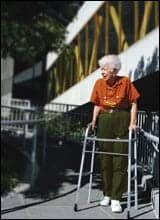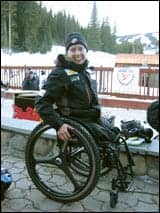 |
| “We look at their equipment needs. Are they using a cane when they need a walker, or vice versa?” —Michelle McCarthy, PT, DPT, OCS |
All of us have fallen at some point in our lives—most as babies, others while learning new sports, and some as a simple result of clumsiness. The occasional spill may be unavoidable, but too many falls may be related to another problem. That problem may be obvious, such as a stroke or neurological disorder, or subtle, such as aging’s weakened muscles. No matter the problem or diagnostic, fall-prevention programs can benefit patients.
Ironically, however, patients often have to fall first, and sometimes often, to realize that a problem exists. “Fall prevention is a misnomer. Often, the people we see for fall-prevention programs have already fallen and injured themselves, or established a pattern of falling,” says Mark Lewis, PT, assistant director at Downeast Rehabilitation Associates in Rockport, Me.
The future of fall prevention may lie in actual prevention, Lewis suggests, but currently, therapists more often focus on treatment after the fact. It may be the primary or secondary therapy, but each program is individualized. The techniques and products used to improve a patient’s balance and reduce a tendency to fall differ according to diagnoses, goals, and capabilities.
CAUSES AND CONSEQUENCES
Naturally, each program begins with an evaluation. One of the first things to consider is the patient’s diagnosis. “Where does the problem come from?” asks Michelle McCarthy, PT, DPT, OCS, Westwood Physical Therapy, Los Angeles.
Conditions include patients with lower-extremity limb amputation; incomplete spinal cord injury; lumbar nerve injuries; neurological problems, such as stroke or Parkinson’s disease; orthopedic conditions; peripheral neuropathies; and vestibular dysfunction. Fall-prevention patients may also include patients older than 70. “We see a lot of geriatric patients who have slowly lost function over time but want to maintain their independence,” Lewis says.
He estimates that approximately 5% to 10% of Downeast’s patients are recommended for fall-prevention therapy. McCarthy estimates that roughly 10% to 15% of her patients are seen for fall prevention.
McCarthy assesses patients in a number of areas, including patient history, balance capabilities, home environment, footwear, and equipment. “We interview the patient to find out about the home environment. We evaluate their footwear—some styles can increase the risk of falling. We look at their equipment needs. Are they using a cane when they need a walker, or vice versa?” McCarthy asks.
McCarthy, like Lewis and many other physical therapists, uses a variety of scales to measure task performance.
“These help to establish a baseline,” Lewis says. They are also used throughout treatment to measure progress. “The scores are used in progress reports for Medicare and in patient-discharge decisions,” Lewis adds.
They can also help to establish and assess progress toward goals. “These tools provide clinical goals, but we also must make functional goals,” Lewis says, asking how the tests translate to a patient’s life. “We need to get to know the patient as a person and find out what is important to them. Do they want to do their own shopping, play with their grandchildren, or interact with the community?” he asks.
McCarthy adds that limitations are an important part of goal setting. “We want them to regain or maintain the highest level of independence with or without an assisted device or orthotic. Not everyone will get back to 100%,” McCarthy says.
LANDING ON THEIR FEET
McCarthy suggests that most patients will require some degree of lower-extremity strengthening and balance training. Westwood uses weights and strength equipment as well as the patient’s own weight. “We do a lot of combinations of lying down, sitting, and standing exercises for the legs,” McCarthy says.
Lewis also focuses on leg strengthening, incorporating exercise machines when possible, stairs when not. Home strengthening programs contribute to strength building and prevention of the atrophy that can occur with aging.
Balance exercises also benefit from the use of equipment. Popular tools include the balance trainers; rocker boards; medicine balls; foam wedges, mats, and rollers; trampolines; balance disks; and sport cords.
Elastic bands are particularly useful when training patients to respond to perturbation forces—in other words, to help patients avoid being knocked over when bumping into obstacles, such as other people. “The cord is attached to the patient on one end and the wall on the other. Patients walk in different directions while the cord pulls them in another direction. This enables them to learn how to correct for a perturbation,” Lewis says.
Exercises such as these require careful guarding, particularly since patient trust is key to performance. Therapists often use bars and spotters (one or two); higher-tech clinics may use equipment that incorporates support, often in the form of grab bars or harnesses.
Both Lewis and McCarthy work in smaller practices and so do not currently have budgets for the digital electronic balance system they both have on their wish lists. Lewis estimates the equipment ranges in price from $3,500 to $30,000, depending on the features offered.
PREVENTION BETTER THAN CURE
Generally, a treatment program runs 6 weeks to 3 months, though patients can be seen longer. “Therapists can take several different approaches, and it may depend on what kind of bells and whistles you have,” Lewis says. Therapists learn how to work with the basics so they do not need the latest tools, but that does not mean they do not want them.
McCarthy thinks products will continue to incorporate computerized technology, making testing and therapy more objective and evidence-based. “Items will also be easier to access and increasingly available for home purchase,” she says.
Lewis thinks the field will develop better tools to detect patients with fall and balance problems—before they fall. “Anyone older than 80 years who falls and breaks a hip has an increased chance of death due to secondary complications, such as pneumonia. Immobilization leads to more muscle wasting, so it is better to prevent a fall from happening at all,” Lewis says.
Prevention will include awareness and education programs; some will also focus on the importance of exercise. Patients may still take that occasional spill, but with therapy they will learn to pick themselves up and move on.
Wren Davis is a contributing writer for Rehab Management. For more information, contact .




